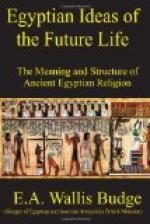As R[=a] was the “father of the gods,” it was natural that every god should represent some phase of him, and that he should represent every god. A good illustration of this fact is afforded by a Hymn to R[=a], a fine copy of which is found inscribed on the walls of the sloping corridor in the tomb of Seti I., about B.C. 1370, from which we quote the following:—
11. “Praise be unto thee, O
R[=a], thou exalted Power, who dost enter
into the habitations of Ament, behold
[thy] body is Temu.
12. “Praise be unto thee, O
R[=a], thou exalted Power, who dost enter
into the hidden place of Anubis, behold,
[thy] body is Khepera.
13. “Praise be unto thee, O
R[=a], thou exalted Power, whose duration
of life is greater than that of the hidden
forms, behold [thy] body is
Shu.
14. “Praise be unto thee, O
R[=a], thou exalted Power, .... behold
[thy] body is Tefnut.
15. “Praise be unto thee, O
R[=a], thou exalted Power, who bringest
forth, green things in their season, behold
[thy] body is Seb.
16. “Praise be unto thee, O
R[=a], thou exalted Power, thou mighty
being who dost judge,... behold [thy]
body is Nut.
17. “Praise be unto thee, O
R[=a], thou exalted Power, the lord....
behold [thy] body is Isis.
18. “Praise be unto thee, O
R[=a], thou exalted Power, whose head
giveth light to that which is in front
of thee, behold [thy] body is
Nephthys.
19. “Praise be unto thee, O
R[=a], thou exalted Power, thou source of
the divine members, thou One, who bringest
into being that which hath
been begotten, behold [thy] body is Horus.




